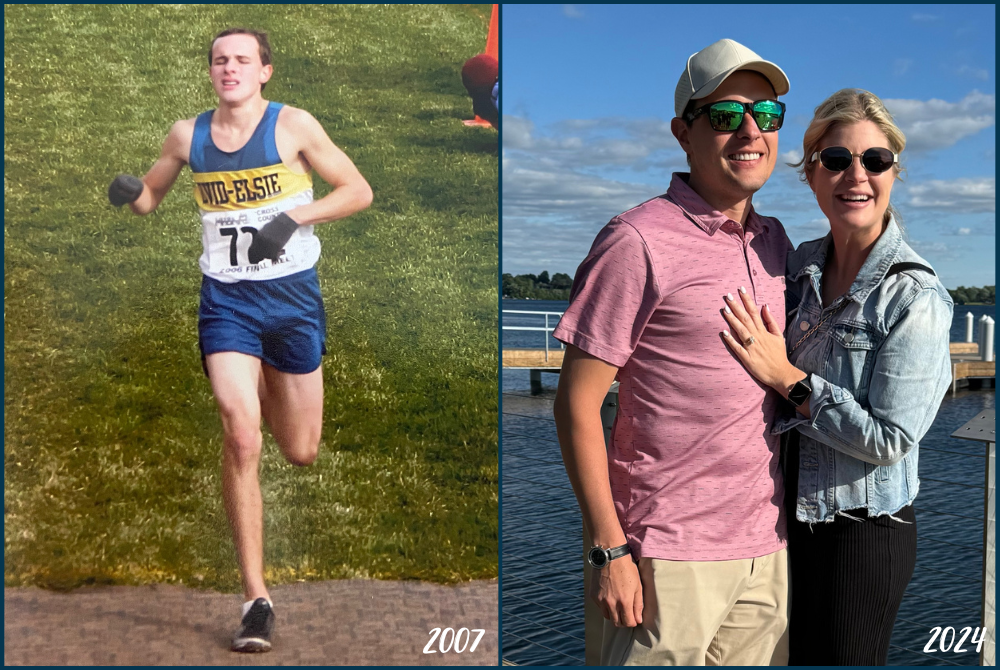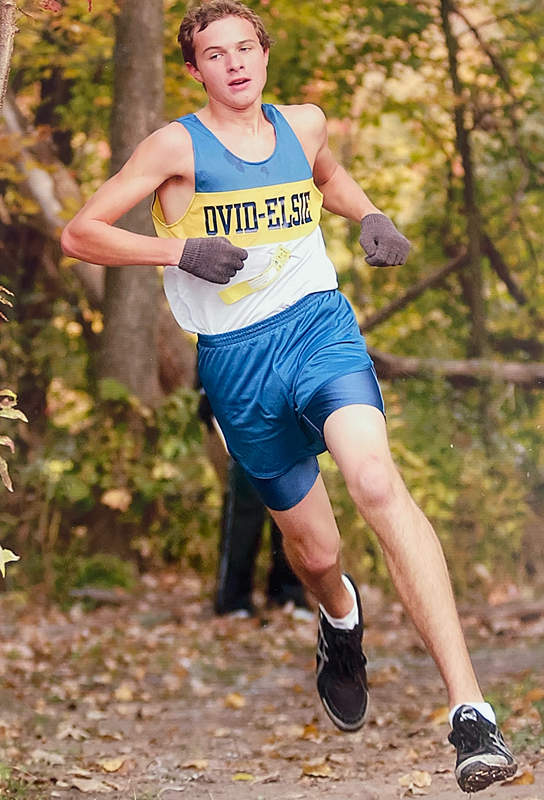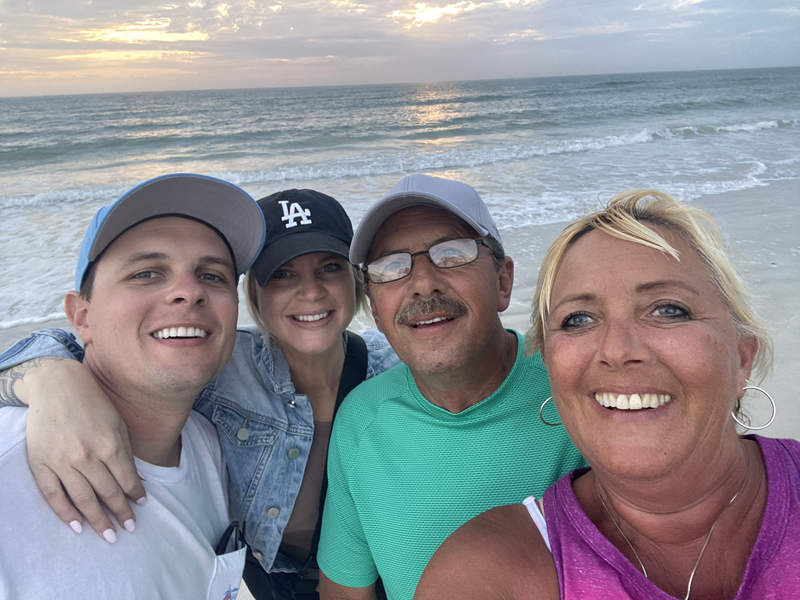
MHSAA Vault: MIS Rose to Challenges to Host 2020 LP Finals
By
Rob Kaminski
MHSAA benchmarks editor
November 12, 2021
The “MHSAA Vault” features stories from past publications and other documents in the MHSAA Library. This issue takes a look at the MHSAA Cross Country Finals at Michigan International Speedway, which celebrated 25 years in 2020 – although it was an event that nearly didn’t happen last fall …
In 1996, the MHSAA and Michigan International Speedway began a partnership the changed the course of the Lower Peninsula Cross Country Finals – quite literally.
The land in and around the track at Brooklyn would host the Finals for all classes of runners in one place on one day, an annual festival of nearly 2,000 runners competing for the MHSAA’s top honors.
Even skeptics – and there were several among running purists who thought the course was too flat, for example – can’t deny the results.
Finals attendance nearly doubled in that first year, and crowds in excess of 10,000 have enjoyed a day of racing several times, including a record 12,153 in 2011.
Enthusiastic crowds were the norm in recent years, with 11,232 in 2017, and nearly 11,000 in 2018 (10,989) and 2019 (10,873).
In fact, attendance failed to reach at least 8,000 only twice since the move to MIS.
Of course, last year was an exception, when attendance was limited to 1,000 spectators per session due to the COVID-19 Pandemic. Fans also were restricted to the grandstands rather than following the action throughout locations on the course.
To reduce the number of runners in each race, the event was spread over two days, with each Division being run in two separate “sections” with times then combined at the end to determine team and individual champions.
While not ideal, the end result was another year of fantastic efforts at MIS – both from student-athletes and those behind the scenes.
“Even at the last hour, less than a week ahead of the Finals, we were closer to not having the Finals than we were to having them,” said MHSAA Assistant Director Cody Inglis, who coordinates the cross country postseason. “Rumors and challenges of mandated shutdowns, testing and other requirements were being discussed and caused a lot of unknowns. Even at the Regional level, we had schools, Regional courses and hosts shutting down their facilities; we had to relocate four Regionals 48 hours prior to race times. That scenario just could not happen at the Finals level where far more runners and much more travel would be involved.”
Among the many last-minute hurdles was the edict from NASCAR – which owns MIS – that all persons on site be temperature checked upon entry. That meant securing thermometers that were easy to operate in short order, along with personnel necessary to conduct the readings.
The attendance limitations certainly helped to implement the temperature screening, but brought their own issues.
“Limiting spectators was not a popular decision, but it really was the only way to have a race,” Inglis said. “We were taking direction and working with policies and protocols from the MDHHS, the Governor’s office, Lenawee County Health Department, MIS and NASCAR.”
Part of the solution was to utilize the grandstands as a “barrier” between participants and spectators. The reduced number of fans were dispersed over thousands of seats while still allowing them the chance to watch their student-athletes compete.
“It wasn’t the same, it wasn’t easy or perfect, but it was what we had to do to have a race,” Inglis said. “Separating the Finals into two days and different sections also allowed us to spread out the event and limit the number of people on site at any one time. This was a key part of the plan and worked well even though it separated races within a Division.”
The MHSAA, MIS and the cross country community never lost focus of the main goal: a culmination of the season for the student-athletes, who deserved something last year more than ever. And, more than ever, MIS once again displayed its advantage as a venue that could adapt to the fluid nature of the times to pull off the event.
“There were some thoughts of using four different sites, but as we learned during the Regionals, the climate of things was so tenuous from one area of the state to another that we couldn’t be 100-percent certain that there wouldn’t again be last-minute cancelations,” Inglis said. “MIS was wonderful to work and collaborate with, and was the best option to get it done. It was never mentioned once publicly about the possibility of not having the Finals – only how we could best do it under uncharted conditions.”
The moving parts and ever-changing scenarios created more complexity than ever in finalizing a season, but every decision was made with the complete desire to conduct the Finals as close to normal as possible.
“I firmly believe that a finish to the season, no matter the differences in race formatting and fan experience, was something everyone would have taken when the season began in August,” Inglis said.
Indeed, the finish line in Year 25 at MIS might have been the most gratifying of them all.

Ovid-Elsie Running Legend Darling Seeking to 'Win the Day' on Trading Floor
By
Paul Costanzo
Special for MHSAA.com
August 13, 2024
Maverick Darling’s competitive running days have been behind him for nearly a decade, but the eight-time MHSAA Finals champion from Ovid-Elsie isn’t done competing.
 Darling, who was also a five-time All-American at Wisconsin, is now fighting for wins on the Viking Forest Products lumber trading floor in Minnesota.
Darling, who was also a five-time All-American at Wisconsin, is now fighting for wins on the Viking Forest Products lumber trading floor in Minnesota.
“Our trading floor is very unique,” Darling said. “We have 60 traders, and probably 30-35 of them are former student-athletes in college. It’s very competitive, but kind of like a locker room. It’s kind of a unique way for me to still be competitive even though I’m not in athletics. I really love it.”
Darling is a commodity trader at Viking Forest, trading mostly OSB, plywood and dimensional lumber to buyers throughout the United States. He lives with his fiancé Danielle and their two dogs in Plymouth, Minn., a suburb of Minneapolis.
Lessons learned while working toward Finals titles on the dirt roads of Ovid and national goals on the trails of Madison, Wis., are helping him find success again.
“My lessons I learned from running and the reward, whether good, great or OK, is that no matter the day, you have to go put in the effort and work, and it carries over to my work,” he said. “I now literally start over every day. We had a saying: ‘Win the day.’ And ‘Win the day’ kind of means something different for every day. I try to apply that to my life. It’s motivating to be successful every day.”
Friendly competition between teammates leading to greater success also carried over from cross country and track to the trading floor.
“We have a department where it feels almost like my cross country team in college,” he said. “One guy will put up 30 orders that day, and we’re all happy for that person. The synergy between the group is awesome. But it motivates me to be like, tomorrow that’s going to be me.”
Darling had spent his first three years out of Wisconsin running professionally and had coaching stops at Iona and Cal-Berkeley after that. But when the pandemic hit, he stepped away from coaching and made the move to trading.
 That ended a spectacular career in the sport, which was actually second choice for most of Darling’s childhood.
That ended a spectacular career in the sport, which was actually second choice for most of Darling’s childhood.
Growing up, he was a top snowmobile racer, along with his brother.
“My first (high school) cross country race, I took seventh,” Darling said. “I didn’t know better, but that’s pretty good. My mom was like, ‘Seventh? You know, we’re used to first or second (in snowcross).’ We’re not a running family. I started at about 18 minutes in the 5K, and at the state meet I finished eighth and ran 16:13. I was like, ‘OK, maybe this is something I can really be good at.’”
It was at the end of his junior year, after winning his heat at the Nike Outdoor Nationals, that Darling turned his entire focus to running. By that time, he had already won two Division 3 cross country titles, two 3,200-meter titles and one 1,600 at MHSAA Finals.
He was training often, but knew he was undertrained because of the limitations on where and when he could run during mid-Michigan winters. Colleges knew it, too, and that led to a barrage of communication as soon as they were able to reach out.
“I probably had 150 of those (hand-written letters) sent to the house,” Darling said. “I would get two to three phone calls a night after July 1. It wasn’t like overwhelming, because I was pretty confident at that point where I wanted to go to school.”
Darling committed to Wisconsin on the day of the Lower Peninsula Cross Country Finals his senior year. He also won his third Finals title that day with a then-Division 3 record time of 14:52. At the time, it was the third fastest time ever run in Michigan.
He would later win his second straight 1,600/3,200 double at the Track & Field Finals, running 8:58 in the 3,200 during the season, which was the 12th-best high school time in the country that year.
The choice to go to Wisconsin was based on his drive to be challenged as much as possible.
“I thought, ‘If I come into this room, I’m probably the eighth or ninth best runner in this room – maybe,’” Darling said. “I had such a great recruiting trip. I grew up in Ovid, and everything I ran there was pretty much dirt roads. Wisconsin has a lot of dirt trails, and I kind of loved that. I could run from our locker room and be on a trail in a mile, mile and a half.”
 Darling’s collegiate career proved he had made the right decision. He was the Big Ten Freshman of the Year for the 2009 cross country season, and an All-American in 2010 and 2012. He was a three-time All-American in track, as well.
Darling’s collegiate career proved he had made the right decision. He was the Big Ten Freshman of the Year for the 2009 cross country season, and an All-American in 2010 and 2012. He was a three-time All-American in track, as well.
The Badgers also had massive team success during Darling’s tenure, winning a cross country national title in 2011, four Big Ten cross country titles and two Big Ten track & field titles.
Darling was surrounded by great runners throughout his time in Madison, including close friend Mohammed Ahmed, who finished fourth in the 10,000 meters at this Olympics, one spot behind another Michigan distance star, Grand Blanc’s Grant Fisher.
Watching the results of a distance boom he was a big part of has been a joy for Darling this summer.
“I thought I was pretty good, then watching these guys – it’s jealousy,” he said with a laugh. “And also, it’s just cool to see. Michigan is one of the best distance states men’s and women’s-wise. It’s great to see them not only be on the international level, but to have that success.”
2024 Made In Michigan
August 8: Shores Star Walker Continues Drive for Hoops Greatness as College Coach - Read
August 6: MCC's Glover Fills Key Role as Athletic Trainer for Super Bowl Champions - Read
August 1: Lessons from Multi-Sport Experience Guide Person in Leading New Team - Read
July 30: After Successful 'Sequel,' Suttons Bay's Hursey Embarking on Next Chapter - Read
July 24: East Kentwood Run Part of Memorable Start on Knuble's Way to NHL, Olympics - Read
July 22: Monroe High Memories Remain Rich for Michigan's 1987 Mr. Baseball - Read
July 17: Record-Setting Viney Gained Lifelong Confidence at Marine City - Read
July 11: High School 'Hoop Squad' Close to Heart as Hughes Continues Coaching Climb - Read
July 10: Nightingale Embarking on 1st Season as College Football Head Coach - Read
June 28: E-TC's Witt Bulldozing Path from Small Town to Football's Biggest Stage - Read
PHOTOS (Top) At left, Maverick Darling crosses the finish line during a race as an Ovid-Elsie senior in 2007; at right Darling poses with fiancé Danielle. (Middle) Darling rounds a turn during a high school race. (Below) Darling and Danielle enjoy a sunset over the water with her parents. (Photos courtesy of Maverick Darling.)

